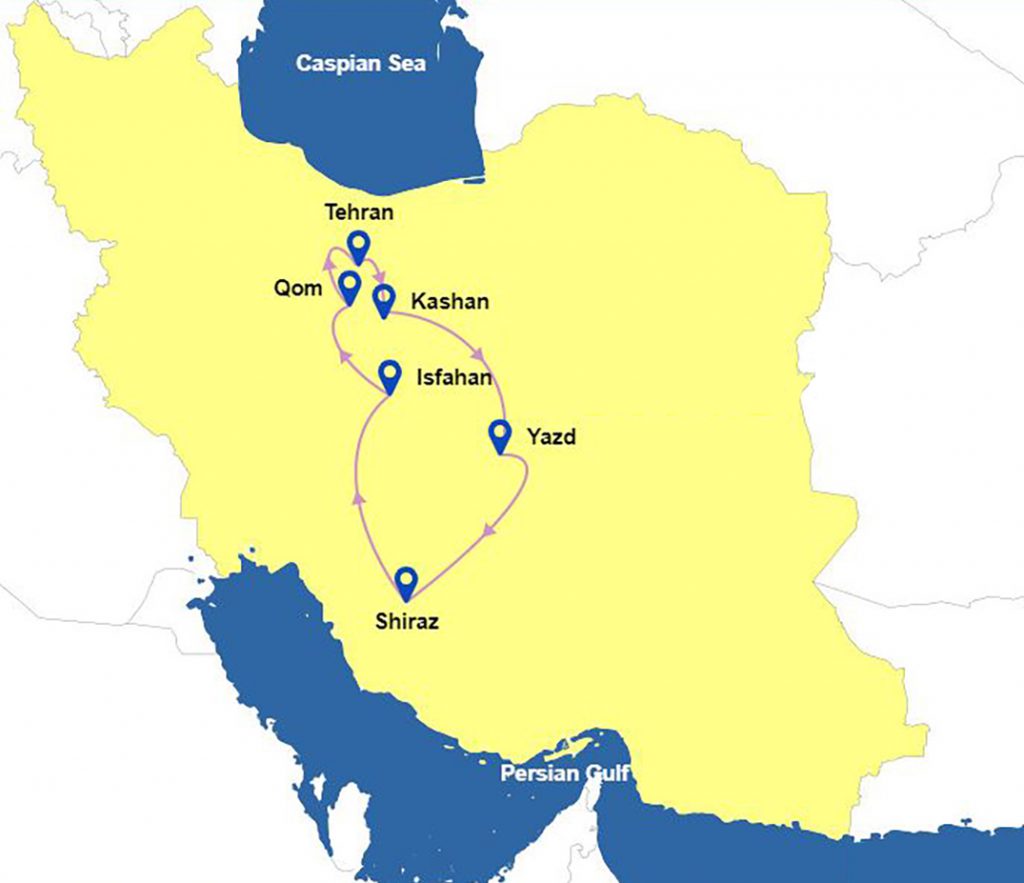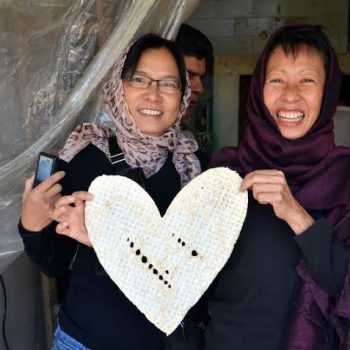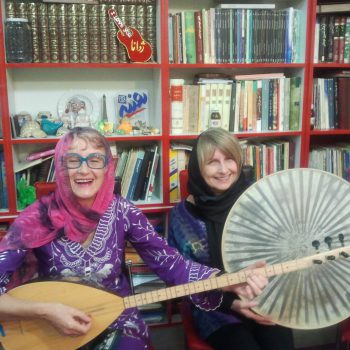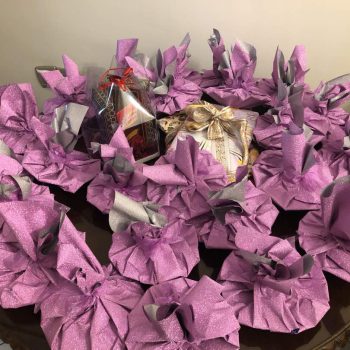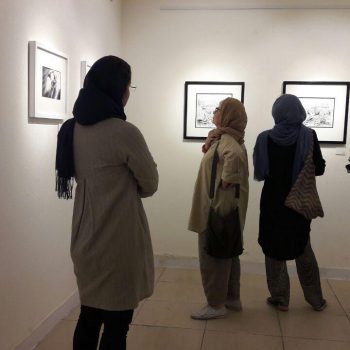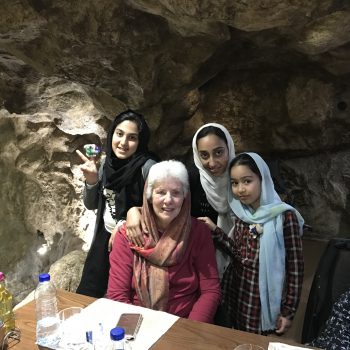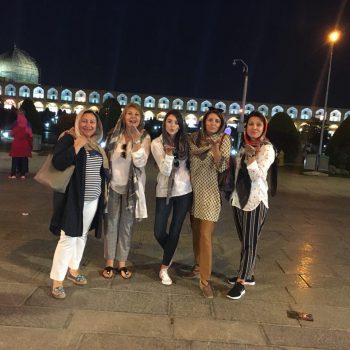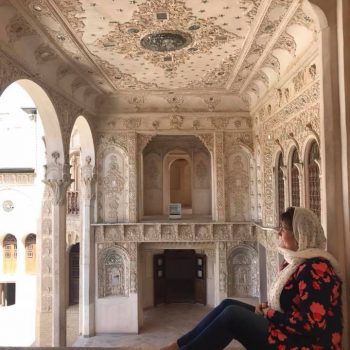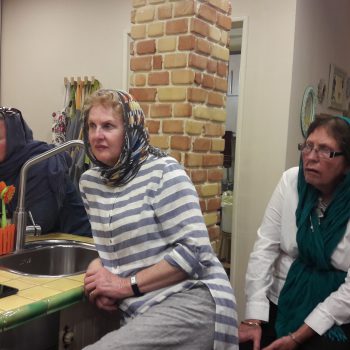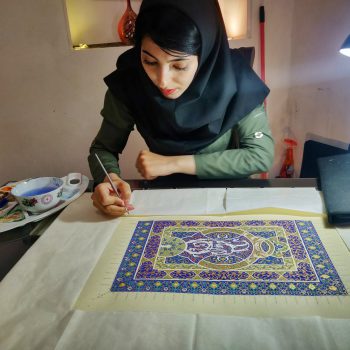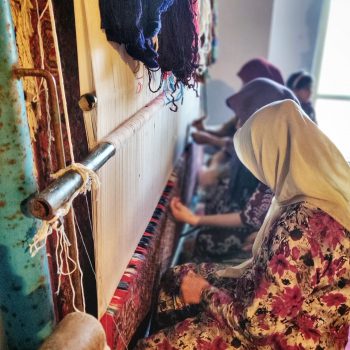Iran Women Tour
16 Days & 15 Nights
We creates Hosted Tours & extraordinary Travel Experiences for Women in IRAN .
Discover new destinations; Learn about new cultures; Experience new activities with our tours .
We design small group tours, adventures, retreats & experiences that provide women who love to travel the world with opportunities to connect with diverse places, cultures & people. We want to help you immerse yourself into local cultures, communities & customs, so we design the kind of unique & inspired experiences that makes travel really special for you.
We want to give you insightful travel experiences in places full of breathtaking landscapes, fantastic food, fascinating cultures & amazing people.
Our tours are designed by Women, for Women; we are here to make travel more accessible for you when you don’t want to do it alone.
Day 1.Tehran
Arrive Tehran After being greeted at the airport we are transferred to our hotel. After a rest and wash, those that wish can spend the afternoon at the Tajrish Bazaar with our Guide. Alternatively, you are free to stay at the hotel and relax this afternoon after your long flight. The Bazaar has been bustling for nearly a thousand years. The stalls are a labyrinth that runs over 10km. The Bazaar has several entrances, its own church, guesthouses and banks. Right in the heart of the Bazaar is the Imam Khomeini Mosque. This mosque was built during the Safavid period and is considered one of the best feats of Persian architecture. This evening we will meet in the Hotel Lobby and enjoy our first group meal together at a resturant under the Alboraz Mountains. Overnight.
Day 2.Tehran
Tehran Full day of sightseeing of Tehran. This sprawling city became Iran’s capital in the 18th century under Agha Mohammad Khan, the founder of the Qajar Dynasty. Tehran (meaning warm slope) is located south of the impressive snow-capped Alborz Mountains and the city is known for its large museums, art centers and palaces. We have lunch at a traditional restaurant who will have arranged several Iranian traditional foods to be presented to us. Today we will visit the following: the Jewel Museum, the National Museum, the Carpet Museum and Golestan Palace. We will have an exclusive visit this afternoon to one of the 6 ‘Women’s Parks’ in Tehran. Women Only parks first opened in Tehran in 2008, where males older than five are forbidden and the guards and gardeners are women. These are parks where women can safely shed their cloaks and headscarves, can scattered about the lawns, sunbathe or exercise. With no men allowed inside the parks, women are able to indulge in such activities as archery, art classes or aerobics without being conscious of their veil slipping or how they talk, laugh or behave. Cameras or mobile phones to take video are forbidden to prevent any invasion of privacy of the women. We will be able to engage in conversation with many of the women in the park and learn more about them and their lives. Overnight Lunch: Traditional Iranian foods at the foot of the Alborz Mountains Dinner will be eaten in the hotel or at a local restaurant.
Day 3. Tehran / Kashan
Kashan This morning we drive to Kashan, a city in the desert of the Esfahan province. The city is world famous for its carpets and also has a name for silk, ceramics, copperware and rosewater. Kashan, often overlooked by tourists, is the first of the large oases along the Qom-Kerman road which runs along the edge of the Great Desert. Its charm is mainly due to the contrast between the parched immensities of the Kavir region and the greenery of the well-tended oasis. This afternoon we visit the Fin Garden (Bagh-e Tarikhi-ye Fin). This is one of the most famous gardens of Iran. This beautiful garden with its pool and orchards was designed for Shah Abbas I as a classical Persian vision of paradise. The original Safavid buildings have been substantially replaced and rebuilt by Qajar dynasty although the layout of trees and marble basins is close to the original. This gorgeous garden with remains of its two story palace is a pleasant spot to relax in the shade. Agha Bozorg Mosque – this mosque and theological school (Madreseh Agha Bozorg) is located in the center of Kashan. The mosque consisted of two large “eivan”, one in front of the “mehrab” and the other by the entrance. The courtyard has a second court in the middle which comprised of a garden with trees and a fountain. Surrounding the courtyard are arcades. The eivan in front of mehrab has two minarets with a brick dome. The colors of arcades and eivan are restricted to blue, red, or yellow against a brick ground. Boroujerdi Residence – the 19th century Boroujerdi Residence used to be a private home but now is open to public as a museum. This house was built in the early 19th century and consisted of a beautiful courtyard, delightful wall paintings and very unusual wind towers which helps cool the house. We also visit Broojerdiha House, which was built in the 1840s for the affluent Tabatabaei family. Overnight Evening free. An optional Group Dinner will be offered this evening.
Day 4. Kashan
Kashan The famous rose fields of Qamsar are very near to Kashan, so you’ll see rosewater stalls everywhere. Rosewater is used in a lot of Iranian desserts. We have an early morning visit to the village of Niasar to watch and take part in the rose picking and see the distillation process. After lunch, we have leisure time to explore the village including the best preserved Sassanian fire temple in Iran dating back 1600 years. Returning to Kashan, we visit the the bazaar. The bazaar of Kashan is one of the most beautiful in Iran. It has many interesting buildings inside; mosques, caravanserais, arcades, baths, and water reservoirs – each were constructed in a different period. We will have an opportunity to visit a 300 year old bath-house within the Bazaar that has been passed down from generation to generation, and is now converted into an incredible Tea House. Feast on dates and biscuits, while you drink tea inside a 300 year old bath house, located in the depths of a 1000 year old Iranian bazaar. Overnight.
Day 5. Kashan / Yazd
Yazd We leave Kashan and make our way to Yazd – the “Queen of the Iranian Desert. Yazd is one of the oldest cities in Iran and one the best examples of a desert city. Because of generations of adaptations to its desert surroundings, Yazd is an architecturally unique city. It is also known in Iran for the high quality of its handicrafts, especially silk weaving, and its sweet shops. En-route we will stop at Naein. The quiet town of Na’in is a place well known for its Persian rugs. We visit the 10th century Jameh Mosque, which is one of the oldest in Iran, as well as the Kavir Museum and the old part of town. We will have lunch in Naein and drive to Meybod. Meybod is a is an ancient city that goes back to pre-Islamic arena and is the home to many ancient points of interests. The Historical City of Meybod is qualifying for inclusion in the World Heritage List. It was the capital of Iran during the Mozaffarid period. One of the oldest castles in Iran is in in Meybod and many important major poets, Sufis, clergymen and politicians came from Meybod. We will visit the Pigeon Tower and Ice House. Overnight This evening we eat dinner at the hotel.
Day 6. Yazd
Yazd After breakfast we visit the impressive Jameh Mosque. The Jameh Mosque (Friday Mosque) crowned by a pair of minarets, the highest in Persia, the portal’s facade is decorated from top to bottom in dazzling tile work, predominantly blue in colour. Within there is a long arcaded court where, behind a deep-set south-east Ivan, is a sanctuary chamber. This chamber, under a squat tiled dome, is exquisitely decorated with faience mosaic: its tall faience Mihrab, dated 1365, is one of the finest of its kind in existence. The Mosque was largely rebuilt between 1324 and 1365, and is one of the outstanding 14th century buildings in Persia. The tile work has recently been skilfully restored and a modern library built to house the mosque’s valuable collection of books and manuscripts. We take a look at the Zoroastrian Fire Temple. The Zoroastrian religion, which dates back over 4000 years, was at one time the state religion of Iran before the arrival of Islam. We also visit the Tower of Silence (Goor Dakhmeh). The Towers of Silence are two Zoroastrian towers set on two barren mountains which provided a ritual site for dealing with death according to Zoroastrian beliefs. Dead bodies would be carried up to, and placed, in the towers so that the vultures could pick the bones clean, maintaining purity of the earth. The Towers were surrounded by walls built to prevent others from seeing the frightening sight of the big birds using their powerful beaks and picking on the body of the deceased. As a result generally in less than an hour nothing of the body would remain other than bones. This practice lasted until the 1960’s. One of the most distinctive features of Yazd are the wind towers (‘badgirs’) that capture even the softest of breezes and send them through the buildings below to cool them. Yazd is also famous for its cakes and sweets; especially baghlava, Qottab, Pashmak and Hadji Badam which are delicacies relished all over Iran. We will visit a famous sweets shop. Overnight Moshir Garden Hotel; or similar. (B/L/D) This evening we eat dinner in a traditional restaurant and enjoy various local foods.
Day 7. Yazd / Zinodin Caravansary
Zein O Din – We have the morning free to explore the Yazd bazaar where you can have lunch at Khan Hammam (Khan Tea House). *A Guide will be on hand if needed. After lunch we depart for Caravanserai Zeinoddin. The Caravanserai Zeinoddin features a rooftop terrace, home-cooked Persian cuisine, and was used as an overnight stop for traders travelling along the Silk Route. From the outside this is a strange outcrop of bricks squeezed between the Dasht-e Lut and the Zagros Mountains. On the inside, however, is a marvellous Persian caravanserai that has been spruced up and softened into an atmospheric place to stay. **Rooms are separated by thick curtains (in the style of an old caravanserai) and the spotless bathrooms are shared, but they have western toilets and hot showers. There are some private rooms that may be available on arrival. But this is a ‘on availability’ basis once we are at the Caravanserai. Views over the desert are especially beautiful at sunset and at sunrise and if you are lucky, the staff may perform some traditional dances for you after dinner. Overnight the Caravanserai Zeinoddin.
Day 8. Zinodin Caravansary / Abarkuh / Shiraz
Shiraz This morning, our journey first takes us across the stunning Zagros Mountains to the historical town of Abarkuh, located in the desert valley beneath the Zagros Mountains. We visit the famous ice house, the Jameh Mosque and a 4,000-year-old cypress tree. We stop at Passargadae; an ancient city that precedes Persepolis. The centerpiece is a large hall with eight columns made of white stone. In the northern doorway, there is an impression of a winged human with two wings directed towards the sky and two wings pointing down. Its hands are raised towards the sky in a gesture of prayer. A mass of black and white stones have been used as construction material. Another characteristic of Passargadae are canals made of white stone, which were used for irrigation. Onto Shiraz, the ‘Pearl of Persia’ – its very name brings forth visions of tranquil gardens, lavish palaces, philosophers, artists and poets. It is Iran’s cultural capital. It is also considered by many Iranians to be the city of gardens, due to the many gardens and fruit trees that can be seen in the city. We have have a picnic lunch en-route and continue to Shiraz. Overnight Dinner at Shahpouri Resturant.
Day 9. Shiraz / Persepolis / Necropolis / Shiraz
Shiraz – Persepolis –shiraz Today we we have a full day excursion to Persepolis to visit the glorious ruins of Achamenians. Persepolis, which in Greek literally means the capital of Persia, lies 36 miles north of Shiraz. Persepolis was the one-time center of the Persian Empire and one of the great cities of the ancient world. Construction began by Darius the Great (521 – 468 BC) as the focus of the mighty Achaemenian Empire nearly 2,500 years ago. The grandeur of these monuments is certainly impressive. We then visit Naqsh-e-Rostam, a cave-tomb containing the bodies of several Achaemenid Kings. There are seven reliefs dating back to Sassanid era, each of which depicts a battle that glorifies a Sassanid King. At one time a Zoroastrian religious center, perhaps once the most important in the world, was located here. Afternoon stop at a traditional tea house for tea and ice-cream. Overnight.
Day 10. Shiraz / Isfahan
Shiraz This morning we embark on a city tour that covers the highlights of this historical city. We visit the lovely Eram Garden or Garden of Paradise (Bagh-e Eram), which has an impressive collection of cypress trees as well as a pond and a small 19th century palace. Following this we visit the tombs of Hafez and Sa’di. Hafez was a Persian poet who was born in Shiraz around 1310. After several years of traveling round the world, he returned to Shiraz and remained there until he passed away. His works were very surreal and mystical and he is still regarded these days as a bit of a folk hero in Iran. His tomb in the beautiful Musalla Gardens, which has been restored many times (present structure was constructed in 1942), is a place of pilgrimage. Sa’di, another great poet and writer from Shiraz, was more of a scholar. His tomb is also set in a garden, beside a fish pond. We also visit the workshops of nomadic rug weavers, woven by nomads who have settled in Shiraz, and a visit to the Shiraz carpet bazaar. We walk around the Bazar-e Vakil, regarded as one of the finest and most evocative bazaars in the country. Overnight.
Day 11. Isfahan
Isfahan This morning, en-route to Isfahan, we have the rare privilege of visiting the Nomads. The wandering tribes of Iran are the world’s largest remaining concentration of traditional nomads – over a million people practicing an ancient way of life, moving with the seasons. Nomads are famous for their origins, their clothing, their tribal structures and traditions and for the scenic beauty of their camping sites. These Nomads migrate from the cooler mountain pastures in summer to the warmer lowland plains in winter to take advantage of seasonal grazing resources. Their principal income from animal husbandry is supplemented by the sale of handicrafts, such as woven kilims, jajim and jol-e-asb (horse blankets), khoorjin (bags), giveh (traditional shoes), and carpets famous for their great variety of colours, and striking patterns. This experience brings you into close contact with these proud, independent people, and offers a unique insight into a way of life that has vanished from so many of the world’s wildernesses. We continue to drive to Esfahan – a jewel in the crown of Persia and a UNESCO World Heritage Site. It was once one of the largest cities in the world and is famous for its’ Islamic architecture – beautiful boulevards, covered bridges, mosques, palaces and minarets. The Naghsh-e-Jahan Square is one of the biggest city squares in the world. Early evening, we can stroll to the Zayandeh River and have a look at the historic bridges where local people gather to talk, drink tea and sing beautiful folk songs. This is truly a magical place to wile away some time in one of the most atmospheric places in all Iran. We will have a picnic lunch en-route. Tonight we will eat dinner and overnight at the fabulous Abassi Hotel. Overnight Abassi Hotel; or similar. (B/L/D) Dinner – Iranian banquet meal at the Abassi Hotel.
Day 12. Isfahan
Isfahan The city of Esfahan reached its peak during the reign of Shah Abbas the Great in 1587 when it became the capital. After an Afghan invasion in 1722, the city declined and the capital was subsequently moved to Shiraz and then Tehran. We start our discovery at the immense Imam Square (formerly Naqsh-e Jahan Square) which covers an area of 82,500 square metres and is surrounded by many grand buildings such as Ali Qapu Palace, Sheikh Lotfollah Mosque, Qeysarieh Portal and the majestic Imam Mosque. Located in the west of Imam Square, the Ali Qapu Palace covers six floors and was originally built as the main palace of Shah Abbas, who used it to receive guests and foreign ambassadors. Its plaster works and paintings are considered as masterpieces of the Safavid era. Chehel Sotun Palace, located in a pleasant garden, is famous for its beautiful collection of frescoes. We also visit Vank Cathedral. This church is located in Jolfa, the Armenian quarter of the city, and is most striking with its gilded ceiling and painting. The Armenian Christians were originally brought there by Shah Abbas I, who valued their skills as artists and merchants. Esfahan also has a wonderful bazaar where we can browse for fabrics, spices, jewellery and other treasures. Lunch will be eaten in a traditional restaurant with different local food (more than 6 kind of foods) such as Okra. We will have tea at the Antique Teahouse in Imam Square. Overnight Abassi Hotel; Dinner this evening will be at a specialty Beryani restaurant.
Day 13. Isfahan
Today we have a tour about the process of carpet weaving and give you one of the best experiences that you can have in your trip to Iran . Hand-woven Carpets is a traditional persian Art. The originality of Persian carpets or Iranian Rugs dates back to about 2500 years ago. Iranians were among the pioneer weavers of the carpets of ancient civilizations, and over the centuries, creativity and genius achieved a degree of great perfection in this field. Carpet weaving skills are passed down through generations as a highly protected family secret. Persian carpets are Hand-knotted with wrap and weft of different materials such as: cotton, wool or silk. They have been woven by love and great artistry to create patterns with balancing colors and earthy undertones.
Day 14. Isfahan / Qum / Tehran
Tehran This morning we continue our journey back to Tehran via the ancient city of Qom. Qom is one of the holiest cities in Iran – and the Middle East – and is entrenched in centuries of history. Qom is considered holy by the Shi’a of Iran as it is the site of the shrine of Fatema Mæ’sume who was the sister of Imam Reza, who lived from 789–816 AD. The city itself is the largest center for Shi’a study in the world and it is a significant destination of pilgrimage. It is counted as one of the focal centers of the Shi’a both in Iran and around the globe. Since the revolution the clerical population has risen from around 25,000 to more than 45,000. Non-Muslims are allowed entry to the city, but they are not allowed entry in the holy shrine unless with a Muslim companion or guide. We settle into our Tehran hotel and in the afternoon we will have time to visit a female (Iranian) artist and Gallery. Overnight We will have our final group dinner at Honarmandan Resturant.
Day 15. Tehran
Depart Our journey in Iran ends this morning after breakfast. We will be transferred to the airport for our International flight(s).

